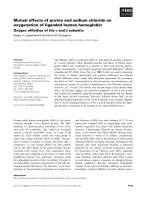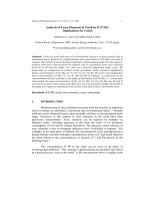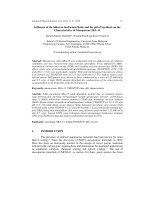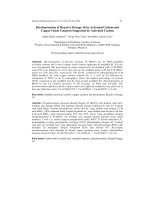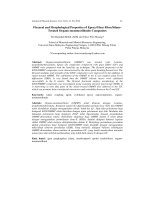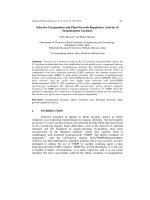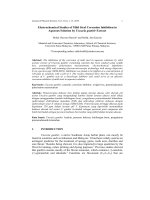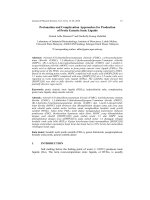Báo cáo vật lý: "Emulsion Polymers of Core-Shell Styrene-Butyl Acrylate: The Effect of Feeding and Aging Time on Particle Size Distribution" pdf
Bạn đang xem bản rút gọn của tài liệu. Xem và tải ngay bản đầy đủ của tài liệu tại đây (255.54 KB, 9 trang )
Journal of Physical Science, Vol. 19(2), 117–125, 2008 117
Emulsion Polymers of Core-Shell Styrene-Butyl Acrylate: The Effect
of Feeding and Aging Time on Particle Size Distribution
Helmiyati* and Emil Budianto
Department of Chemistry, FMIPA, University of Indonesia, Depok 16424, Indonesia
*Corresponding author: Helmi-yt@ ui.edu
Abstract: Core-shell polymers in the particle size range 200–300 nm having a
monodisperse distribution and opal color are prospective materials for coating
applications. The emulsion polymerization of the core-shell was done using two
monomers with significantly different refractive indices styrene for the hard monomers
and butyl acrylate for the soft monomers. The feeding and aging time were varied, with
particle size shown to increase with decreasing feeding time. Increasing the aging time
increased conversion but had no effect to the particle size even after two hours producing
particles in the 200–300 nm range. The obtained core-shell emulsion polymers were
characterized by determining particle size and polymers morphology by TEM.
Keywords: core-shell, emulsion, styrene-butyl acrylate, particle size, feeding time, aging
time, color effect
1. INTRODUCTION
The ability to control particle properties like size and morphology has
increased research interest in emulsion polymerization. The desired outcome
depends on the physical properties of starting polymers, such as glass transition
temperature and chemical properties, structure and monomer chain length.
1
Polymers are used to effect color in coating application and monomer type
and polymerization technique are important controlling parameters. There has
been much research done in this area. One method to control color is by selective
reflection, usually accomplished with chemical dyes containing chromophore
groups. The color effect from polymers core-shells is caused by the (111) plane
reflection of the face-centered cubic (fcc) lattice. Particle diameter must be 200
< D < 300 nm, so that the light will be reflected in the range of visible light. The
latest research on core-shell emulsion polymers uses two co-existent polymers
phases to select the color used in coating applications.
5,6,7
A decade ago, research on the color effect of film crystals based on the
theory of light reflection is originated from the work of Yablonovitch and John.
Yablonovitch and John predicted that three dimensional crystals with lattice
Emulsion Polymers of Core-Shell 118
spacing of the light wavelength scales and a strong periodic refractivity
modulation exhibit photonic band gaps. Light within these gaps cannot propagate
in these photonic crystals, so external light is reflected and the internal light
emitted locally by flourescence at lattice defects. These properties make photonic
crystals the optical equivalent of semiconductors. The optical properties depend
on the difference in refractive index between the particle spheres within the
matrixs.
3,4,5
Much of the past work on the color effect of polymers reflecting light in the
visible, region focuses on emulsion polymerization of styrene and methacrylate
derivatives without a surfactant.
8,9,10
Recent research by that Ruhl et al.
6,7
showed
that it is possible to obtain color effects using injection molding of plastic
products.
Examination of the phenomena of the light reflection of colloid crystal
films was made using latex emulsion particles, which have the potential for use in
new materials for their effect on color. The color effect caused by monodisperse
particle in the crystal lattice reflects visible light. These polymers are called
colloid crystals or opal, taken from name of opal gems that are perhaps the best-
known example of photonic band structures in nature. Latex emulsion particles
can be fabricated that resemble the colloid crystals. To use emulsion particles that
replicate the crystal colloid opal structure, the structure must consist of a hard
core and a soft shell. Hard core forms the crystalline lattice while the soft shell
forms a matrix around them. There is no free space between the spheres. The
color effect is caused by plane reflection (111) of the fcc lattice. The colloid
crystals material is analogous to the periodic structure of the simple salt NaCl
crystal. The fcc is a simple example that reflects light and is shown in Figure 1.
Figure 1 shows that the fcc lattice is characterized by the next-neighbor
distance d. The normal vector q111 of the (111) plane runs through one space
diagonally. This (111) plane almost always extends parallel to the film surface in
Figure 1: Fcc crystal structure.
Journal of Physical Science, Vol. 19(2), 117–125, 2008 119
opal films. Important planes, besides (111), are the (-111) family [-111, 1-11, 11-
1], the (200) family [200, 020, 002] and the (220) family [220, 202, 022]. Each
family consist of three planes 120
0
apart, with a spacing a
hkl
and forms an angle
ϕ
hkl
with the film surface of four of these planes, as indicated in Figure 1 edge-on.
The spacing a
hkl
and angle
ϕ
hkl
are given by:
=
hkl
a
2
d
222
h+k+l
,
h+k+l
cosj =
hkl
222
3(h + k + l )
(1)
Light entering an opal film surface at an angle
θ
is refracted according to Snells
law and proceeds in the film at an angle
δ
:
cosθ
n=
cosδ
(2)
where n is the average refractive index, which depends on wavelength (
λ
).
White light consists of wavelengths λ inside the window (400–700 nm).
To place the interval (
λ
min
,
λ
max
)
111
into this visible window, the diameter of the
latex spheres is given by:
32
3
1,1
D
dd=≅
Π
(3)
Diameter of the latex particle must be in the range 200 < D < 300 nm. For
D ≅ 180 nm, only violet is observed at
θ
= 90
o
and for D ≅ 400 nm, only red at
θ
= 0
o
.
6,7
This study on the emulsion polymerization core-shell is done in two steps
for two monomers with different refractive indices for application in coatings.
The hard monomer is styrene (Tg, 100°C), and the soft monomer is butyl acrylate
(Tg,–54°C), with sodium lauryl sulfate (SLS) used as surfactant and ammonium
persulfate (APS) as the initiator. In the experiment, both the feeding and aging
time were varied. The feeding time was shown to effect particle size, which
increased with decreasing feeding time obtained. The aging time is post
polymerization, and it is estimated that at this step, propagation and termination
are occurring and will be effected. Increasing the aging time lengthens the
propagation step and slows down termination, the resulting polymer will have a
higher solid content and the particle size will remains in the 200–300 nm range.
Journal of Physical Science, Vol. 19(2), 117–125, 2008 120
2. EXPERIMENTAL
2.1 Materials
Styrene and butyl acrylate were used as monomers, sodium lauryl
sulphonate as the surfactant, APS as the initiator and acrylic acid as the stabilizer.
The cross-linking agent was made up of glycidyl methacrylate, potassium
hydroxide (KOH) and deionized water.
2.2 Procedures
Process equipment used in the emulsion polymerization were a mini
reactor equipped with a reflux condenser, agitator/stirrer, thermometer, dropping
funnel (through which the monomer feed was added to the reaction mixture),
analytical balance and glassware. Characterization was determined using an oven
for the determination of solid content (SC), Malvern Zeta Nano Particle Analyzer
Nano Series (Nano S) for measuring particle size and a Shimadzu Transmission
Electron Microscopy (TEM) for polymers morphology.
2.3 Polymerization of Core-Shell Styrene-Butyl Acrylate
Emulsion polymerization of the core-shell structures was prepared using
a two-steps polymerization process. The first step is the formation of a polymer
core that is encapsulated with a cross-linking agent. In the second step, the butyl
acrylate monomer is polymerized to styrene core to produce the final emulsion
polymers core-shell. The process was done in a semi-continuous seeded reaction
system. The reactor vessel was filled with a seeded mixture of water, surfactant
and styrene monomer. The composition of styrene in the seed was less than in the
overall mixture. The mixing speed was held constant at a rate of 200–300 rpm.
The reaction temperature was set to 75°C, which is the decomposition
temperature of the initiator APS to form free radical sulfate ions.
3. RESULTS AND DISCUSSION
3.1 Emulsion Polymerization of Core-Shell Styrene-Butyl Acrylate
with Varying of Feed Time
Synthesis of core-shell styrene-butyl acrylate emulsion polymers in this
research was done using the seeding technique, where the reactor was filled with
an initial charge or seed and heated until 75
o
C for one hour, and then the initiator
was charged for 10 min. Pre-emulsion took place in the dropping funnel under
continuous flow into the reactors at constant speed. The rate of pre-emulsion or
Journal of Physical Science, Vol. 19(2), 117–125, 2008 121
feeding was kept constant to maintain small droplets, and influenced the particle
size of the emulsion polymers.
Different feeding times were used over the course of this work; it was
observed that short feeding times yield bigger particle sizes with higher solid
content. This was in agreement with work by Bao et al.
[11]
who found that short
feeding times result in larger particle size. A two steps feeding process was used
where the first is for the formation of the core styrene and the second is for
grafting butyl acrylate to the styrene core to complete the shell (ratio of core-shell
to feeding time). The results of the conversion and particle size to the ratio of the
feeding time are given in Table 1.
Table 1 shows that as the feeding time of the core and shell increases, so
does conversion and the results are presented in Figure 2. For the feeding time
ratio 2:2, the conversion is low, and increasing the ratio to 2:3 increases the
conversion, however further increases in the feeding time ratio do not
significantly affect conversion. The feeding time optimum was obtained with the
ratio 2:3, which is a feeding time of 2 h for the core styrene and 3 h for the shell
butyl acrylate. Figure 2 also shows the influence of feeding time ratio on particle
size.
Table 1: The conversion and particle size for different ratios of feeding time.
Ratio of
feeding time
(Core:Shell)
Feeding time
of core
styrene (h)
Feeding time of
shell butyl
acrylate (h)
\
Conversion
(%)
Particle size
(nm)
2:2 2 2 50.5 94.1/798.6
2:3 2 3 62.4 264.7
3:4 3 4 65.5 222.5
3:5 3 5 65.5 108.2
Figure 2: Conversion and particle size of feeding time.
Emulsion Polymers of Core-Shell 122
The particle size distributions for the different feeding times are
presented in Figure 3. For ratio of feeding time 2:2, the particle size distribution
is polydisperse or polymodal, with peaks at 94.1 nm and 798.6 nm [Fig. 3(a)].
This is because the feeding time of 2 h is too short to complete the grafting of
butyl acrylate to the styrene core, which is only partially completed; a secondary
core is formed by the homogeneous nucleation from droplets of monomer or
oligomer with the termination of the external of micelle.
Figure 3(b) shows the particle size distribution for the feeding time ratio
2:3, with a peak of 264.7 nm. This is a relatively big particle size, the feeding
time for formation of core styrene 2 h and 3 h for the grafting of butyl acrylate is
optimum for the formation of the polymer core-shell. Figure 3(c) shows the
particle size distribution for the ratio 3:4, and gives a particle size 222.2 nm. This
particle size is still within the desired range, meaning that the feeding time ratio
is still suitable for the formation of polymer core-shells. For Figure 3(d), the
particle size decreases to 108. 2 nm, indicating that the increase of feeding time
for butyl acrylate to 4 h results in particle sizes of the polymers core-shell that are
too small.
3.2 Emulsion Polymerization of Core-Shell Styrene-Butyl Acrylate with
Various Aging Time
The conversion results of core-shell polymers at various feeding times
are low, so the aging time was increased in an attempt to improve this. Aging
time is the time at which the feeding has finished (post polymerization step).
Aging is strongly influential in the process for the final polymerization result. In
Figure 3: Distribution of particle size for different experimental feeding time ratios. (a)
2:2; (b) 2:3; (c) 3:4; and (d) 3:5.
Journal of Physical Science, Vol. 19(2), 117–125, 2008 123
the aging step, propagation and termination occur, and if not completed, a low
conversion is obtained. This research has shown that aging time significantly
affects the polymerization result.
Figure 4 and Table 2 show the effect of aging time on the conversion of
core-shell emulsion polymers. The results indicate that the conversion increases
with aging time. An aging time of 30 min yielded low, leaving unreacted
monomers in the propagation step. At an aging time of 120 min, the optimum
conversion is observed and then no further increases are seen with increases in
aging time.
In Figure 4, it is seen that an increase of aging time to 2 h significantly
raises the conversion. This lengthened aging time gives more opportunity for the
oligomer radicals to react during propagation. In addition to the effect of
conversion, the impact on particle size is important. Results of core-shell
polymers with aging times of 30 min and 2 h gave a particle size of 257.4 nm and
264.7 nm, respectively. It means that aging times up to 2 h do not affect the
particle size. This is illustrated in Figure 4, as all particles fall within the 200–300
nm range.
Figure 4: Plot of conversion and particle size as a function of aging time.
Table 2: Effect of aging time on the conversion of core-shell styrene-butyl acrylate
polymers.
Ratio of Aging time
(Core: Shell)
Aging time of core
styrene (min)
Aging time of shell
butyl acrilate (min)
Conversion
(%)
1 [1:1] 30 30 50.5
2 [1:1] 60 60 62.4
3 [1:1] 90 90 80.0
4 [1:1] 120 120 85.0
5 [1:1] 180 180 85.0
Emulsion Polymers of Core-Shell 124
3.3 Morphology of Core-Shell Styrene-Butyl Acrylate Polymers by
TEM
Figure 5 shows the TEM of the core-shell polymer particles. The image
shows that polymers consist of spherical structures, with the particle size
distribution of 200–300 nm and is monodisperse.
4. CONCLUSION
The latest research on core-shell emulsion polymers is of interest because
the properties of two co-existent polymers phases will be reflected in the color if
used for coating application. In this work, the emulsion polymers that having a
core-shell structure of styrene-butyl acrylate with monodisperse particle sizes
from 200–300 nm have been explored.
The feeding time was shown to be an important parameter on particle
size, which increased with decreasing feeding time. The study showed that,
during the synthesis, using a feeding time for the formation of the styrene core of
2 h, and 3 h for the shell yielded polymer particles size of 264.7 nm.
Increasing the aging time was shown to increase conversion which was
shown to be optimal at 2 h. Aging time was not shown to influence particle size,
and times up to 2 h, all obtained particles were within the 200–300 nm range.
Figure 5: Morphology of core-shell polymer particles (5 000x).
Journal of Physical Science, Vol. 19(2), 117–125, 2008 125
REFERENCES
1. Urban, D. & Takamura, K. (2002). Polymer dispersion & their industrial
applications. New York: Wiley-VCH.
2.
Tayeb, G., Gralak, B. & Enoch, S. (2003). Structural colors in nature
and butterfly-wing modeling. Optics and Photonics News, 40–49,
February 2003. New York; Wiley-VCH.
3.
Yablonovitch, E. (1987). Inhibited spontaneous emission in solid-state
physics and electronics. Phys. Rev. Lett., 58, 2059–2062.
4.
John, S. (1987). Strong localization of photons in certain disordered
dielectric superlattices. Phys. Rev. Lett., 58, 2486–2489.
5.
Ruhl, T. & Hellmann, G.P. (2001). Coloidal crystals in latex films
rubbery opals. Macromol. Chem. Phys., 202, 3502–3505.
6.
Ruhl, T., Spahn, P. & Hellmann, G.P. (2003). Artificial opals prepared
by melt compression. Polymer, 44, 7625–7634.
7.
Ruhl, T., Spahn, P., Winkler, H. & Hellmann, G.P. (2004). Large area
monodomain order in colloidal crystals. Macromol. Chem. Phys., 205,
1385–1393.
8. Egen, M. & Zentel, R. (2002). Tuning the properties of photonic films
from polymer beads by chemistry. Chem. Mater., 14, 2176–2183.
9. Egen, M., Braun, L., Zentel, R., Tännert, K., Frese, P., Reis, O. & Wulf,
M. (2004). Artificial opals as effect pigments in clear-coatings.
Macromol. Mater. Eng., 289, 158–163.
10. O’Callaghan, K.K., Paine, A.J. & Rudin, A. (1995). Emulsion polymeri-
zation of supermicron, monodisperse acrylic copolymer particles with
core-shell structures. J. Polym. Sci. Pol. Chem., 33, 1849–1857.
11. Bao, Y.Z., Huang, Z.M. & Weng, Z.X. (2004). Particle features of a poly
(methyl methacrylate) resin prepared by a new emulsion polymerization
process. J. Appl. Polym Sci., 94, 1905–1911.
